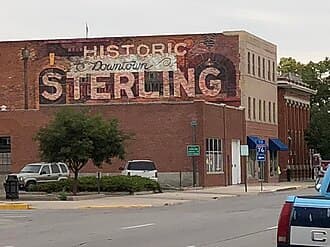Sterling Historic District Anchors Downtown Revival and Cultural Economy
The Downtown Sterling Historic District, listed on the National Register of Historic Places in 2013, remains a focal point for Logan County civic life, cultural events, and downtown economic activity. Its concentration of late 19th and early 20th century commercial and civic buildings, anchored by the Logan County Courthouse, matters for local planning, tourism, and property investment.

The Downtown Sterling Historic District, roughly bounded by Division Avenue, Poplar, Front, Ash and Fourth Streets, is both a preserved architectural collection and an engine for downtown activity in Sterling. Added to the National Register of Historic Places in 2013, the district contains commercial storefronts, civic structures and institutional buildings that date from the late 19th and early 20th centuries. The Logan County Courthouse stands as a central civic anchor within the district, drawing daily visitors and ongoing county business that underpins foot traffic for nearby retailers and service providers.
Historic designation provides practical benefits that matter for local budgets and planning. Listing on the national register creates eligibility for state and federal preservation grants and historic rehabilitation tax incentives, avenues local property owners can pursue when renovating older buildings. Those financial tools can lower the cost of bringing aging building stock up to current safety and accessibility standards while retaining historic character. For small downtown landlords and business owners, that can mean higher occupancy rates and reduced vacancy risk over time.
The district also serves as a cultural nexus. Community festivals, seasonal events and heritage programming commonly center on the downtown core, concentrating visitors in a compact area where restaurants, shops and professional services can capture spending. For Logan County residents, these activities generate both quality of life benefits and local economic impacts, keeping sales and hospitality dollars circulating in town rather than leaking to regional retail centers.
From an economic development perspective, preserving a distinct historic district is a strategy for differentiation. Rural and micropolitan downtowns across the country face pressure from online shopping and large format retail, which erode traffic for traditional retailers. Maintaining intact historic streetscapes gives Sterling a comparative advantage in heritage tourism and in attracting entrepreneurs seeking unique commercial space. The courthouse and surrounding historic fabric provide visual authenticity that new construction cannot replicate.
Policy choices at the county and municipal level will influence how much economic benefit the district captures. Coordinated efforts to help property owners access preservation funding, targeted façade improvement programs, clearer signage and a year round events calendar can increase visitation and private investment. Zoning and parking policies that support pedestrian activity and mixed use occupancy are complementary measures.
Looking ahead, the Downtown Sterling Historic District is more than a collection of old buildings. It is a strategic asset for Logan County that links cultural identity to measurable economic outcomes. With deliberate preservation policy and active promotion, the district can continue to anchor downtown revitalization, support local businesses and sustain civic life for years to come.


